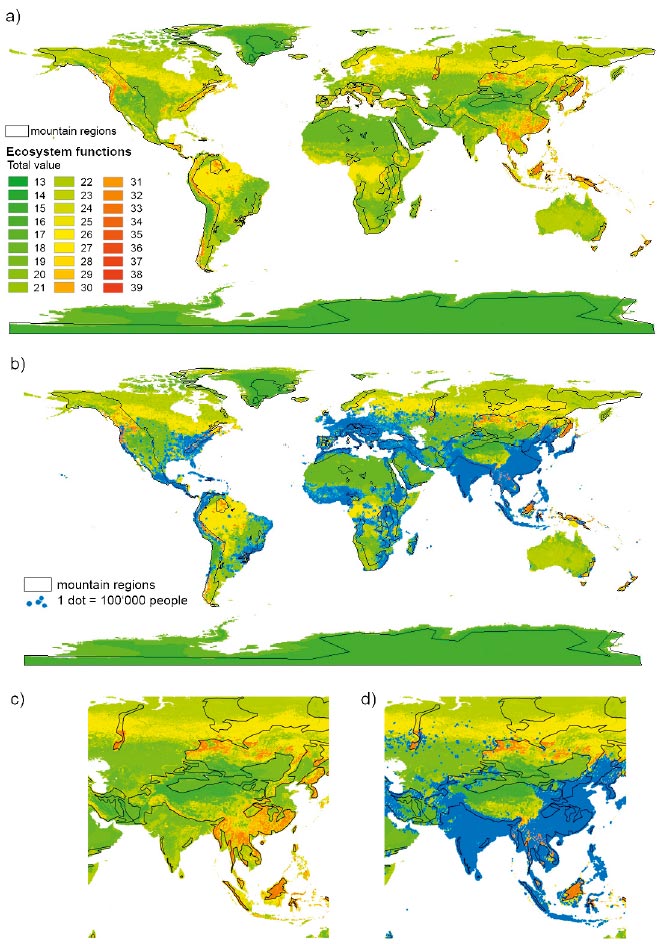While climate change may bring some benefits to mountain regions (e.g. longer growing seasons), the preponderance of impact is negative. Increased variability in precipitation patterns (including variability in monsoon and more frequent extreme rainfall) coupled with glacial ice melt, is predicted to increase risks of floods (carrying rock, sediments and debris), landslides, fire, soil erosion and spread of water-related and vector-borne diseases (Ebi et al. 2007; Armstrong 2010; Ahmed and Suphachalasai 2014). Of particular concern are the potentially devastating impacts from glacial lake outburst floods which have become more frequent since the middle of the 20th century (Armstrong 2010; International Centre for Integrated Mountain Development 2011).
The Hindu Kush Himalayas, the greater Himalayan region extending from eastern Nepal and Bhutan to northern Afghanistan, are among the most extensive areas covered by glaciers and permafrost on the planet. They contain water resources that drain through ten of the largest rivers in Asia, from which over 1.3 billion people derive their livelihoods and upon which many more depend for water and other resources (Eriksson et al. 2009). The region has been recognized as a unique biodiversity-rich area with equally unique topographic characteristics and socioeconomic and environmental challenges. The accelerated rate of warming, glacier ice melt and related implications on the hydrological systems are among the most pressing challenges to this unique mountain ecosystem (Gerlitz et al. 2017). It is essential that these macro-climatic effects are integrated into plans to conserve the fragile biodiversity of the region.
Mountain ranges cover around 22 per cent of the terrestrial space of the planet and provide multiple ecosystem services. At lower elevations, mountain habitats, especially those in tropical regions, are often more biodiverse and have higher levels of endemism than adjacent lowlands. However, habitat degradation and fragmentation has impacted many mountain ecosystems (Shrestha, Gautam and Bawa 2012; Chettri 2015; Venter et al. 2016) (see Section 4.3.2). Mountain ecosystems are especially vulnerable to climate change: effects include shifts in species ranges and composition, with notable impacts on those organisms whose dispersal might be limited, or which are restricted to high altitudes, and local extinctions can occur for species in the upper margins of elevation gradients (Pauli et al. 2012; Khan et al. 2013; Grytnes et al. 2014; Knapp et al. 2017). Climate-induced warming can change ecosystem functioning, advance spring phrenology, and increase productivity and carbon uptake (Piao et al. 2012; Shen et al. 2016). Localised pressures include road construction, deforestation, mining, tourism, grazing of domestic livestock, burning and armed conflict (see Epple and Dunning 2014; Young 2014).
Most mountain areas today are under high human pressure, including the Tropical Andes and Central Asian Mountain biodiversity hotspots. The Himalayas, with approximately 19,000 species (Khan et al. 2013), have been documented as highly vulnerable to climate change (Shrestha, Gautam and Bawa 2012). In Europe, warming has driven many species upward, resulting in local increases of boreal and temperate mountaintop diversity; but the opposite effect has been noted for Mediterranean mountains, which have lost some species (Pauli et al. 2012). In some areas, the abandonment of agricultural land in mountain ranges has also led to decreases in biodiversity, especially among bird populations (Hussain et al. 2018).

Loss of biodiversity reduces nature’s contributions to people in both mountains and lowlands (Figure 6.19) (Grêt-Regamey, Brunner and Kienast 2012). Degradation in mountain ecosystems will result in changes in air quality and climate regulation, such as the reduction of greenhouse gas sequestration (Ward et al. 2014). Threats to local communities include loss of food security, medicinal plants, and water quality and provision, and increased exposure to risks associated with landslides, sedimentation of rivers and flooding modifying their livelihoods and land cover (Eriksson et al. 2009; Khan et al. 2013; Young 2014). A few mountain areas still maintain the traditional use of species (e.g. Andes, Himalayas), while ethnobotanical knowledge in the Alps has been lost due to changes in land-use patterns (Khan et al. 2013). Glacier loss impacts water security, with some populations in South Asian countries dependent upon the flow of rivers from the western but also central and eastern Himalayas (Khan et al. 2013; see Box 6.7). Economic costs of land-use change may also be high; for example, a 75 per cent reduction in economic benefits from nature-based recreation has been reported following replacement of mountain forest with crops in Nepal (Thapa et al. 2016).